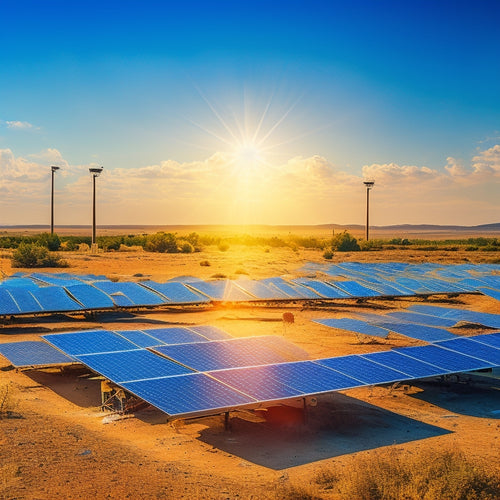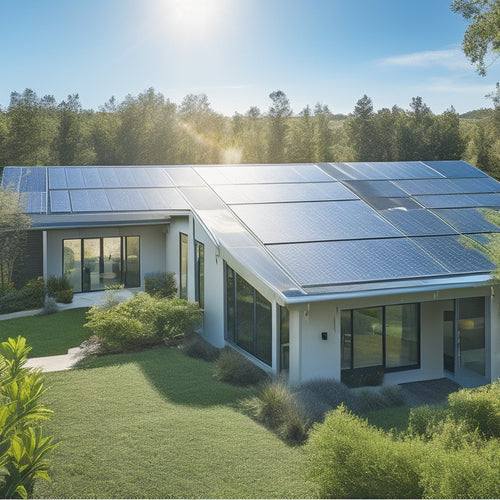
Micro Solar Panel
Share
You're considering micro solar panels, which can greatly enhance your energy independence by capturing more morning light and maximizing energy harvesting efficiency. By maximizing morning energy output, you can reduce your reliance on traditional energy sources and decrease your energy bills and carbon footprint. Efficient energy conversion, bypass diode functionality, and ideal power output and voltage ratings are key to achieving this. Additionally, compact designs can provide space efficiency and flexibility. As you investigate the world of micro solar panels, you'll uncover how these innovative technologies can further improve your energy independence and renewable energy goals.
The Essentials
- Micro solar panels are designed for morning efficiency, capturing maximum morning light to boost daily energy production and reduce reliance on traditional energy sources.
- High-efficiency solar panels can increase energy production by up to 22%, and optimal panel angles guarantee maximum sunlight exposure for increased output.
- Bypass diode functionality minimizes power losses, ensuring optimal performance of solar panels, and efficient diode selection prevents energy loss due to heat buildup.
- Micro solar panel power output typically ranges between 5-20 watts, with voltage ratings corresponding to power output, and efficiency increases with higher power output.
- Compact design and space efficiency enhance power-to-area ratio, making micro solar panels ideal for applications with limited installation space.
Capture More Morning Light
You can capitalize on the early sunrise advantage by angling your micro solar panel to capture more morning light.
This is especially significant for off-grid living or camping trips where a reliable source of renewable energy is essential Renewable Energy Solutions.
By doing so, you'll optimize your morning energy output, resulting in a significant increase to your overall daily energy production.
Early Sunrise Advantage
As the sun rises earlier in the day, micro solar panels can capitalize on this early morning light to generate more power.
By utilizing Home Solar Battery technology, you can store excess energy generated during the morning hours for use during periods of low production or grid outages.
You can take advantage of the sunrise benefits by positioning your micro solar panel at an ideal angle to capture more morning light.
This results in increased solar efficiency, allowing you to generate more power during the early hours of the day.
By doing so, you can maximize your energy output and make the most of the available sunlight.
When you utilize the early morning light, you can reduce your reliance on traditional energy sources and enjoy greater energy independence.
This is especially important for those who value freedom and self-sufficiency.
By capitalizing on the early sunrise advantage, you can generate power when you need it most, reducing your energy bills and carbon footprint.
With micro solar panels, you can unleash the full potential of the morning sun and take control of your energy needs.
Optimized Morning Energy
Micro solar panels optimized for morning energy capture can greatly improve power generation during the early hours. When you install micro solar panels designed for morning energy efficiency, you'll notice a significant increase in energy production. This is because morning sunlight is often more intense and consistent, making it an ideal time for energy harvesting.
By integrating a reliable solar energy storage solution, you can store excess energy generated during the morning for use during the night or on cloudy days, guaranteeing a continuous power supply. Additionally, morning energy efficiency is critical, as it allows you to generate power when you need it most – during peak morning hours when energy demand is high.
To maximize morning energy capture, consider installing micro solar panels at an angle optimized for morning sunlight. This will guarantee that your solar panels receive the most direct sunlight possible, resulting in higher energy output.
Increased Energy Harvesting
You're looking to maximize the energy output of your micro solar panel, and that requires efficient energy conversion and maximum power output.
By optimizing these key factors, you can greatly increase the amount of energy harvested from the sun. In fact, high-efficiency solar panels from top manufacturers like SunPower and Tesla have been shown to increase energy production by up to 22% top solar panel efficiency.
Your micro solar panel's performance will directly benefit from these enhancements, allowing it to generate more power from the same amount of sunlight.
Efficient Energy Conversion
Within the micro solar panel, efficient energy conversion is essential to maximize the amount of electrical power generated from sunlight. As you investigate the possibilities of renewable energy advancements, you'll find that solar panel technology has made considerable progress in recent years.
When sunlight hits the photovoltaic cells, it excites the electrons, which then flow through an electrical circuit to generate power. However, not all of the sun's energy is converted into electrical power. You'll want to optimize the energy conversion process to minimize energy loss and maximize output.
To achieve this, you'll need to take into account factors such as the type of photovoltaic material used, the surface area of the solar panel, and the temperature at which it operates. By selecting high-efficiency solar cells and optimizing the panel's design, you can increase the amount of electrical power generated per unit area.
Additionally, advances in solar panel technology have led to the development of more efficient inverters, which convert the DC power generated by the solar panel into AC power that can be used in your home or business.
Maximum Power Output
Optimizing the energy conversion process is just the first step in utilizing the full potential of micro solar panels. To maximize power output, you need to guarantee that your micro solar panel is operating at its peak efficiency. This requires careful consideration of panel efficiency, which refers to the percentage of sunlight that's converted into usable electricity.
A high-efficiency micro solar panel can appreciably increase your energy harvesting capabilities. For instance, a panel with an efficiency rating of 22% can generate more power per unit area than a lower-efficiency panel.
To further enhance power output, you can use a micro inverter, which converts DC power from each panel to AC power, allowing for maximum power point tracking (MPPT) at the individual panel level. This ascertains that each panel operates at its ideal level, even in partial shading or mismatched conditions.
Efficient Bypass Diode Function
You'll want to guarantee that your micro solar panel's bypass diode function is optimized, as it plays a vital role in minimizing power losses, especially in off-grid systems where energy storage is essential Renewable energy.
The diode activation threshold is a key parameter to evaluate, as it directly affects the diode's ability to prevent power loss during shading or mismatch conditions.
Diode Activation Threshold
A specific voltage threshold triggers the activation of bypass diodes in a micro solar panel, guaranteeing that the energy harvesting process operates efficiently. You need to understand that this threshold level varies depending on the type of diode used. For instance, Schottky diodes typically have a lower threshold level compared to standard PN junction diodes.
When the voltage across a solar cell string exceeds the diode's activation threshold, the bypass diode begins to conduct, diverting excess energy away from the shaded or underperforming cells. This prevents energy losses due to heat buildup and guarantees that the entire solar panel operates within its ideal power output range.
In a micro solar panel, the diode activation threshold is critical to maintaining efficient energy harvesting. By selecting diodes with ideal threshold levels, you can minimize energy losses and maximize the panel's overall performance.
It's crucial to take into account the specific requirements of your micro solar panel application when choosing the right diode type and threshold level to guarantee ideal energy harvesting.
Power Loss Reduction
By ensuring the bypass diode functions efficiently, micro solar panels can greatly reduce power losses. This is essential because power losses can greatly impact solar panel efficiency. You can achieve efficient bypass diode function by optimizing micro inverter technology. This technology allows each solar panel to operate independently, reducing the impact of shading or malfunctioning panels on the entire system.
| Parameter | Efficient Bypass Diode Function |
|---|---|
| Power Loss Reduction | Up to 20% increase in solar panel efficiency |
| Operating Temperature | -40°C to 85°C |
| Reverse Current Protection | Up to 15 A |
| Bypass Diode Voltage | 15 V to 30 V |
| Response Time | < 1 ms |
Check Wattage and Voltage
You need to ascertain your micro solar panel's power output falls within a suitable range, typically between 5-20 watts, depending on your application's requirements.
When integrating solar panels with advanced battery solutions, such as renewable energy storage, it's vital to take into account the overall energy output.
Additionally, you must verify the voltage rating, as it's important to match the panel's output voltage with your system's voltage tolerance to prevent damage or inefficiencies.
Power Output Range
Efficiency demands precise measurement, and micro solar panels are no exception. When it comes to power output range, you need to know exactly what to expect from your micro solar panel. This is essential for power efficiency and energy storage. The power output range of a micro solar panel is typically measured in watts (W) and volts (V).
Here is a breakdown of the power output range for different micro solar panel models:
| Model | Power Output (W) | Voltage (V) | Efficiency (%) |
|---|---|---|---|
| MSP-10 | 10 | 12 | 20 |
| MSP-20 | 20 | 18 | 22 |
| MSP-30 | 30 | 24 | 25 |
| MSP-40 | 40 | 30 | 28 |
As you can see, the power output range varies depending on the model and voltage. You'll notice that the higher the power output, the higher the voltage and efficiency. When choosing a micro solar panel, consider your energy storage needs and select a model that meets your power output requirements. By doing so, you'll guarantee maximum power efficiency and get the most out of your micro solar panel.
Voltage Rating Importance
With micro solar panels, power output and voltage go hand-in-hand. You need to take into account both factors when selecting a micro solar panel for your specific application. The voltage rating is a critical aspect, as it directly affects the panel's efficiency. A higher voltage rating typically means better efficiency, but it also increases the panel's cost.
When comparing micro solar panels, you should prioritize voltage rating alongside wattage. A higher voltage rating allows for more efficient energy transmission, reducing energy losses during transmission. This is particularly important for off-grid systems or those with long cable runs.
For instance, a 12V panel may be suitable for small, local systems, but a 24V or 48V panel would be more efficient for larger, more complex systems.
In an efficiency comparison, a higher voltage rating generally translates to better performance. However, it's crucial to balance voltage rating with wattage and cost considerations.
Compact Design Saves Space
You'll appreciate the space-efficient module design of micro solar panels, which allows for a higher power-to-area ratio.
This compact design enables you to generate more power in a smaller footprint, making them ideal for applications where space is limited.
Space-Efficient Module Design
As the demand for renewable energy sources continues to grow, micro solar panels must adapt to accommodate limited installation spaces, making compact design a crucial aspect of their development. You require innovative materials and installation flexibility to maximize energy output while minimizing space usage.
| Design Approach | Benefits |
|---|---|
| Thin-film technology | Reduces material usage, increases flexibility |
| Bifacial design | Enhances energy output, reduces space requirements |
| Foldable panels | Enhances portability, simplifies installation |
Frequently Asked Questions
Can Micro Solar Panels Be Used for Indoor Lighting?
You can utilize natural light for indoor applications, achieving energy efficiency by installing micro solar panels, which convert sunlight into electricity, allowing you to power indoor lighting, reducing your reliance on traditional energy sources and embracing freedom from grid dependency.
Are Micro Solar Panels Waterproof and Weather-Resistant?
"When it rains, it pours," but you're wondering if your outdoor lighting solution can withstand the elements. Rest guaranteed, micro solar panels are designed with durability in mind, featuring panel protection that guarantees weather-resistance and waterproofing, giving you the freedom to illuminate your space, rain or shine.
Can I Connect Multiple Micro Solar Panels Together?
When connecting multiple solar panels, you'll want to guarantee compatibility to maintain micro panel efficiency. Check voltage and current ratings, then connect in series or parallel, keeping in mind solar panel compatibility, to optimize energy output and achieve the freedom you desire.
Do Micro Solar Panels Require Special Installation Tools?
When setting up solar panels, you'll want to check the installation requirements for specific tool recommendations, as some may need specialized connectors or wrenches; research the manufacturer's guidelines to guarantee a smooth, independent installation process.
Can I Use Micro Solar Panels to Charge My Phone?
When you're on-the-go, you're probably wondering if you can capture the sun's power to charge your phone. Fortunately, yes, you can, and micro solar efficiency makes it possible; with the right phone charging options, you'll be juicing up in no time, enjoying freedom from outlets.
Final Thoughts
You've got a micro solar panel that's optimized for maximum energy harvesting. By capturing more morning light, increasing energy harvesting, and efficiently handling bypass diodes, you're getting the most out of your panel. Don't forget to check wattage and voltage to verify compatibility. With its compact design, you're saving space without sacrificing performance. Curiously, a 1% increase in energy harvesting can translate to a 10% increase in revenue for solar farms, highlighting the importance of efficient micro solar panels.
Related Posts
-

Building an Emergency Backup Solar Power System in 5 Essential Steps
Building an emergency backup solar power system involves five key steps. First, assess your daily energy needs to ide...
-

What Happens Without a Charge Controller in Solar Panels
Without a charge controller in your solar panel system, you risk overheating batteries due to overcharging, which can...
-

Installing Metal Solar Roofs for Maximum Energy Efficiency
Installing metal solar roofs can drastically enhance your home's energy efficiency and durability. These roofs withst...


